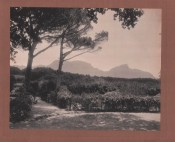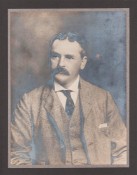9 individual photographs housed in a specially made full red leather portfolio titled gilt on the upper cover, the edges of which are scuffed and worn, 1 of the interior flaps to hold the photographs in place is detached, and one is almost detached. 8 photographs are folio sized (250 x460mm) mounted on boards, 5 depicting aspects of the exterior of the house and vistas, 2 are of the interiors and one portrait of Henry Feltham, one is smaller (260 x 400mm) showing the extensive tree lined avenue leading up to the house. All are embossed underneath Edwards Claremont Cape Town S.A. and are undated [c. 1900]
From the Feltham family archive. Henry Feltham was a prominent lawyer in Johannesburg and owner of the Stellenberg Estate in Kenilworth in the Cape. He died in Johannesburg on 14 June 1929.
Extracted from his obituary in The Star 14 June 1929: A link with the early days of Kimberley and Johannesburg has been broken by his death. A charming personality and cultured gentleman, who was one of the best known and highly respected citizens of Johannesburg. Between 1884 and 1898 he pleaded at the Bar in Kimberley. He was attracted to Johannesburg where there was greater scope and opportunity for his professional ability. He was a recognised authority on company law and company practice in South Africa.
Accompanying the portfolio is a range of related material on the house extracted from various sources including the following:
2 handwritten extracts from the Historic Houses of the Cape by Dorothea Fairbridge published in 1922 which include several loose photographs and a sketch of plate V11 from this book.
The Illustrated London News October 1926 page 775: Old world houses in South Africa which mentions Stellenberg with a colour illustration of the house by Gwelo Goodman.
The Star 14 June 1929 : Obituary of H.L.L. Feltham owner of the property.
Advert in the local newspaper [Cape Times or Argus] Public sale of the Historic residence Stellenberg House on 27 November 1930 - the estate of the late H. L. L.Feltham including the letter from the African Board of Executors mentioning this sale.
Auction catalogue of the property by J. J. Hofmeyr &Son to be auctioned on 6 May 1934 and subsequently sold to Professor Saint.
Cape Times February 5 1953: Showplace of the Cape once changed hands for 8 Pounds. 6S by Madeleine Masson.
There are several views of the house, one published in colour as a Xmas card, and one black and white photograph professionally mounted in a cream card folder.
The Cape Dutch homestead known as Stellenberg has played many roles during its long and interesting history – farm dwelling, manor house, country retreat, patrician residence, provincial heritage site and much-loved family home.
Situated at the crossroads of what were once four oak lined avenues in upper Kenilworth and surrounded by enchanting gardens and mature trees, Stellenberg is the last example of its kind in the central southern suburbs. Simon van der Stel originally granted an estate of 57 morgen to Jacob Vogel in 1697 but it was almost immediately transferred to his youngest son, Frans van der Stel on extremely favourable terms. Senior officials of the Dutch East India Company were forbidden to grant land to their relatives, so Frans made a token payment to the temporary owner.
In 1707 the Van der Stel brothers Willem Adriaan and Frans were banished from the Cape. Some years later Stellenberg was sold to Christina van Canarij, one of the three pre-eminent and successful slave women freed by Simon van der Stel. Formerly a member of Van der Stel’s household, she featured in a documentary film about the three pioneering women made in 1996. She lived in the original dwelling on Stellenberg with her husband until her death in 1725.
Stellenberg’s next owner of note was the affluent businessman John Stanton White, one of the first Englishmen to settle at the Cape, who was known locally as Jan de Wit. His son Petrus inherited the property in 1767 and transferred it to Charles van Cahman, and by 1783 the estate extended over approximately 120 Morgen. Johan Isak Rhenius bought the property in 1795.
It is likely that the present U-shaped house had its beginnings during the De Wits’ ownership (1742 to 1768) and was embellished by Van Cahman and Rhenius - both wealthy individuals – during the last years of the eighteenth century. It is almost certain that the services of the celebrated architect Louis Michel Thibault were employed, for evidence of his skill may be seen in the perfect proportions of the façade and in the very fine front gable. Thibault’s hand is also seen in the piers and wreathed urns on the gateposts, and on the unique teak railings and vase-topped columns that enclose the back courtyard.
The master sculptor Anton Anreith created the beautiful bas-relief that fills the gable pediment and has also been credited with the glazed screen inside the house, which is said to be the earliest example of its kind at the Cape.
Rhenius, who was acting governor for 13 months during the final years of Dutch rule, was appointed receiver-general and treasurer by the incoming British in 1795. In 1802, following the Treaty of Amiens, control of the Cape was restored to the Dutch, and Abraham de Mist was appointed Commissary General. As political head of the Cape administration, he occupied Stellenberg during the ownership of Mynhardt van Schoor.
At that stage the property covered an area of what later became prime building land in Claremont and Kenilworth. In 1845 the owners of Stellenberg sold the now handsomely treed gardens in Claremont to Ralph Arderne, a passionate plants person and gardener. He transformed the land into what has become a popular public park known as the Arderne Gardens.
Although most of the ground has since been sold, today the original werf and the extensive gardens of Stellenberg remain. The homestead escaped Victorianisation, a fate suffered by many old houses at the Cape, thanks to the Feltham family, who owned Stellenberg for 50 years from 1878. They strenuously resisted suggestions that they remove the gable, replace the thatch with corrugated iron and update the windows and shutters.
Since 1931, Stellenberg has had three owners who have cherished and improved the property: Professor C.F.M. Saint who held the first chair of surgery at the University of Cape Town, Robin Stratford, and finally the Ovenstones, who acquired Stellenberg in the early 1950s.
Over 60 years later, Stellenberg remains in superlative condition. Indeed it has been described by historians and architects as one of the most beautiful Cape Dutch houses in the Cape Peninsula, with its balanced design, classical decoration, its wide welcoming portal and renowned gardens.http://stellenberggardens.co.za/our-history
- Size: Folio (470 x 360 mm)
- Sold By: Clarke's Africana & Rare Books
- Contact Person: Paul Mills
- Country: South Africa
- Email: [email protected]
- Telephone: 021 794 0600
- Preferred Payment Methods: Visa & Mastercard via PayGate secure links and Bank transfers.
- Trade Associations: ABA - ILAB, SABDA






























